FOOD CHAINS are a great way to demonstrate how energy is transferred between plants and animals.
EVERYTHING starts with…
THE SUN…
Then PLANTS-plants use the SUN to make their own food….
Then ANIMALS-eat the plants and other animals for food….
Then HUMANS-also eat the plants and other animals for food.
Imagine you’re in a forest, and there are lots of animals living there. Now, think about who eats who. Let’s start with a simple example:
- Grass: At the bottom of the food chain, you have plants like grass. They make their own food through a process called photosynthesis, using sunlight, water, and nutrients from the soil.
- Rabbit: A rabbit comes along and eats the grass. So, the rabbit is one step above the grass in the food chain. We call animals like rabbits “herbivores” because they eat plants.
- Fox: Now, let’s say a fox comes along. It eats the rabbit. The fox is a “carnivore” because it eats other animals.
So, in this simple food chain, you have grass being eaten by a rabbit, and the rabbit being eaten by a fox.
But wait, it doesn’t end there!
- Decomposers: After the fox dies, decomposers like bacteria and fungi break down its body into nutrients. These nutrients go back into the soil, which helps new PLANTS, like grass, to grow again. So, in a way, the decomposers are completing the cycle by recycling nutrients.
That’s the basic idea of a food chain. It’s like a line of who eats who in nature. And it’s essential for keeping ecosystems balanced and healthy!
Alright, let’s break it down more:
Producers, Consumers, Predators, Decomposers
What eats what: A food chain is like a line-up of who eats who in nature. It shows how energy and nutrients flow from one living thing to another.
- Starting point = PRODUCERS: It begins with plants or producers. These are things like grass, trees, or algae. They make their own food using sunlight, water, and nutrients from the soil
- Next up = CONSUMERS: Then come the plant-eaters, called herbivores. They munch on plants to get their energy. For example, rabbits, deer, and caterpillars are herbivores.
- Further up = PREDATORS: After that, there are animals that eat other animals. These are carnivores or predators. Think lions, wolves, and snakes. They hunt and eat the herbivores.
- The circle of life = DECOMPOSERS: But it doesn’t stop there. After an animal dies, decomposers like bacteria, fungi & insects break down its body. They turn it into nutrients that go back into the soil. This helps new plants grow, closing the loop of the food chain.
So, a food chain is like a big CIRCLE OF LIFE, where each living thing plays a part in keeping the balance of nature.
HERBIVORE, CARNIVORE, OMNIVORE
Imagine you’re at a big buffet table….
- Herbivores are like the guests who only eat the salads, fruits, and vegetables. They love munching on plants!
- Carnivores, on the other hand, are like the guests who go straight for the meats – they love eating animals!
- Omnivores are like the guests who enjoy both the salads and the meats. They eat a bit of everything – plants and animals!
- Herbivores:
- Herbivores are animals that mainly eat plants.
- Their teeth are usually flat and good for grinding plant material.
- Examples of herbivores include cows, horses, rabbits, and deer.
- They get all their energy and nutrients from plants like grass, leaves, and fruits.
- Carnivores:
- Carnivores are animals that mainly eat other animals.
- They have sharp teeth and strong jaws, perfect for catching and tearing meat.
- Examples of carnivores include lions, tigers, wolves, and eagles.
- They get their energy and nutrients from the flesh of other animals, like fish, birds, or mammals.
- Omnivores:
- Omnivores are animals that eat both plants and animals.
- They have a mix of teeth, some for grinding plants and others for tearing meat.
- Examples of omnivores include humans, bears, pigs, and raccoons.
- They can enjoy a wide variety of foods, including fruits, vegetables, nuts, seeds, insects, fish, and meat.
So, herbivores eat plants, carnivores eat animals, and omnivores eat both plants and animals
THE CIRCLE OF LIFE-Nature’s Perfect Recycling System
- Starting point: Imagine you’re in a beautiful garden. In this garden, there are plants like flowers, trees, and grass. These plants are like the beginning of the circle of life.
- Animals and people: Now, think about all the animals and people that live in the garden. They eat the plants for food to get energy. Whether it’s a rabbit nibbling on a carrot or you enjoying a salad, plants give us the energy we need to move and play.
- Return to the soil: When animals and people eat plants, they use some of that energy to grow and do their activities. But they also have parts they don’t need, like leaves, or when animals go to the bathroom. These parts go back to the soil.
- Decomposers at work: Now, here’s where the magic happens! Tiny creatures like bacteria, fungi, and worms, which we call decomposers, come into play. They break down the leftover plant parts and animal waste. This turns them into nutrients, which are like plant food, helping new plants grow.
- New plants grow: With the help of these nutrients, new plants grow in the soil. And the cycle starts all over again!
So, the circle of life is like a big recycling system. Plants give us energy, we give back to the soil, and the soil helps new plants grow. It’s all connected, and it keeps nature in balance. Cool, right?
Click here for some great books on various food chains:
Click here for a fun board game to help teach the kiddos about Food Chains:
Watch this great video to understand how nature feeds itself!
There are different types of food chains for different ecosystems.
Check out this one from Florida’s Everglades (swamplands).











[…] And we’ve gone over how Nature feeds itself in our FOODCHAINS lesson (click here)… […]